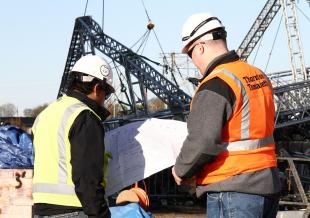News & Resources
Explore our News & Resources

Forensic Investigations
Forensic Investigation in the Age of the Internet of Things
Time is of the essence during the data acquisition phase of a forensic structural investigation; the preservation of post-failure site conditions may be limited and access to the site may be restricted. The acquisition of accurate and timely information from the field is a vital component of every forensic structural investigation and often occurs during limited time frames. Laser scanners and vibration sensors are becoming ubiquitous on construction sites.

Forensic Investigations
Damage Detection Using Large-Scale Covariance Matrix
Statistical pattern recognition based structural damage detection is often developed exploiting the methods of outlier analysis. In this context, damage occurrence is assessed by analyzing whether a set of features extracted from the response of the system under unknown conditions departs from the population of features extracted from the response of the healthy system. The metric dominantly used for this purpose is the Mahalanobis Squared Distance (MSD). Evaluation of MSD of a point from a population requires the use of the inverse of the population’s covariance matrix.

Forensic Investigations
Consequence-Based Robustness Assessment of A Steel Truss Bridge
Aim of this paper is to apply to a steel truss bridge a methodology that takes into account the consequences of extreme loads on structures, focusing on the influence that the loss of primary elements has on the structural load bearing capacity. In this context, the topic of structural robustness, intended as the capacity of a structure to withstand damages without suffering disproportionate response to the triggering causes while maintaining an assigned level of performance, becomes relevant.

Forensic Investigations
Analytical Approaches for Investigating the Cause of the I-35 West Bridge Failure
The I-35 West Bridge in Minneapolis Minnesota collapsed on August 1st, 2007 at 6:04 pm killing 13 people and injuring many more. A nearby security camera captured a video of the collapse. In order to determine the cause of the collapse, a set of analysis results using finite element models and hand calculations were combined into one non-linear model to simulate what occurred on the day of collapse. The collapse model contains the non-linear material properties, loading scenario and findings from the inspection history of the bridge.

Forensic Investigations
Forensic Investigation Modeling: A New Forensic Tool
The investigation into the causes of the collapse in Minneapolis in August 2007 of the I-35W bridge required sifting through a vast amount of design, retroft, and maintenance data prior to initiating the complicated work of analyzing the condition and loading of the bridge at the time of collapse. A new forensic tool—forensic information modeling—was created to store all of these data, as well as the geometry, as a three-dimensional visual database, enabling the engineers to pinpoint possible trouble areas in need of further inquiry.

Forensic Investigations
The Indiana State Fair Collapse Incident: Anatomy of a Failure
On the evening of August 13, 2011 the Temporary Ground-Supported Structure Used to Cover the Stage Area and Support Equipment in the Production of Outdoor Entertainment Events located over the Grandstand Stage at the Indiana State Fair (the ISF Structure) collapsed while the audience was waiting for the headline act to begin. The incident resulted in the death of seven individuals and a multitude of serious injuries.

Forensic Investigations
2-D Seismic Soil-Structure Interaction Study, Transbay Transit Center
The Transbay Transit Center (TTC) will be located in downtown San Francisco, California, and will serve 11 transportation systems including the future High Speed Rail. The proposed structure is 1,500 feet long, and consists of 6 stories, including below-grade trainbox and 5.4 acre rooftop park. Series of two-dimensional seismic soil-structure interaction (SSI) analyses were performed, including fully-coupled direct solution approach as well as substructuring approach. “Scattered” motions, soil springs and dashpots were developed at different locations along the structure.

Hydrogen Engineering
Experimental study on hydrogen explosions in a full-scale hydrogen filling station model
In order for fuel cell vehicles to develop a widespread role in society, it is essential that hydrogen refuelling stations become established. For this to happen, there is a need to demonstrate the safety of the refuelling stations. The work described in this paper was carried out to provide experimental information on hydrogen outflow, dispersion and explosion behaviour. In the first phase, homogeneous hydrogen–air mixtures of a known concentration were introduced into an explosion chamber and the resulting flame speed and overpressures were measured.
